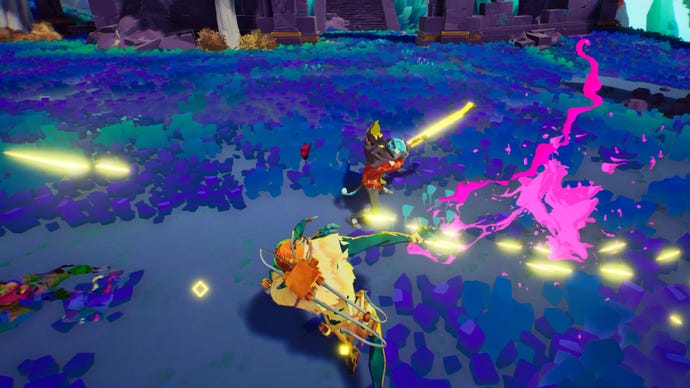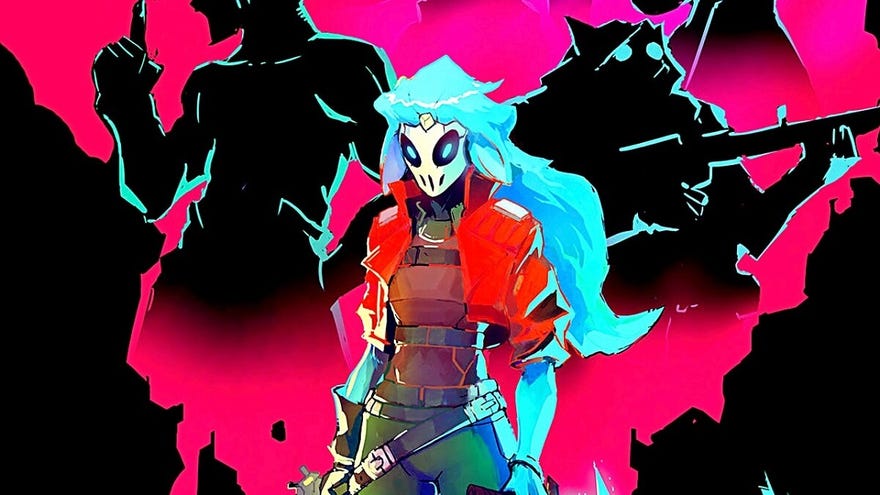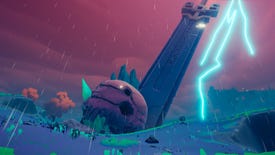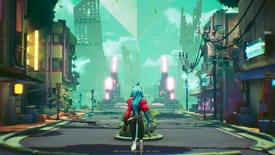Hyper Light Breaker's 3D reworking of Drifter's combat is promising but a little raw
A dimension too far?
I didn't have any particular expectations for Heart Machine's open world roguelike Hyper Light Breaker, but I wasn't expecting it to feel so... broken-up, I guess. In this sequel to 2016's alternately wistful and frenzied action-RPG, you are a debonair-looking sod with a hoverboard, paraglider, blades and guns, sent out into the procedurally generated realms of the Overgrowth to kill Abyss Kings, eat stat boosts and extract with loot.
The aforesaid hoverboard and glider, together with the streaking neon visual direction, suggest a game of fluid acrobatics, akin to the studio's last release Solar Ash, which, to quote Ed's review, "has you rollerblade around shattered worlds like a post apocalyptic gazelle on wheels". Perhaps that game exists deeper within Hyper Light Breaker, but during my 20 minutes with the game at GDC, I found myself stopping and starting and struggling to build momentum using a combat system that felt both deliberately challenging and stilted.
The cynical among you may already be bashing out comments about journalists sucking at games, so let me piously acknowledge that RPS has a track record for finding Hyper Light games tricky, and that I personally am no triple-S platinum-tier progamer, even when I'm not horribly jetlagged. But I'm not sure Breaker's staccato feel is entirely down to my errant thumbs. It might also be down to Hyper Light's embrace of the third dimension, which is somewhat of a surprise when you consider that this is Heart Machine's second 3D action game. But Solar Ash felt designed for it in a way that Hyper Light Breaker doesn't. I'm indulging in childish projection, (see: "horribly jetlagged") but there's a sense that it misses being 2D and regards the player with resentment.
A quick rundown of the basics: you've got regular attacks, "flash step" attacks that launch you towards a target (perhaps to keep a combo going, say), chargeable finishers, parries, dashes that confer some invincibility, and ranged attacks that switch you to an over-the-shoulder perspective. The opposition in my demo consisted of green slimes that posed minimal threat, gangs of more intimidating gremlin skirmishers, combined-arms forces including shooters who fled on approach, and ogre bosses who can happily pancake you in a couple of hits.
Enemies have pronounced tells for easier parrying - a clownish overarm wind-up, or a beam of red light from a gun, with accompanying audio effects distinct enough to register while playing the game on a noisy conference floor. Despite this, I was repeatedly caught out. The gremlins in particular have moves that appear to home a little, and that travel a long distance through intervening enemies and cosmetic fixtures.
Hyper Light Drifter had similar means of making you suffer, but it also had a top-down perspective, and cleaner arena or room-based battles. Breaker spills all that out across a mixture of procedural and hand-crafted 3D geography with vegetation and changes of elevation, and the result is greater potential for being ambushed simply because an enemy's haymaker happened to start a little out of eyeshot. I also had a hard time dodging projectiles, with shots occasionally seeming to connect even though I'd ducked out of the way.

In general, I found my character to be unwieldy and a little unresponsive. Equipped with dual knives and a pistol, they're one of several classes you'll be able to choose from in Breaker's final form, so perhaps I simply drew the short straw this time round. However, while the conspicuous recovery times of your attack and damage animations nudges you to memorise the inputs and avoid over-committing, Breaker's delays feel a little too drawn-out versus the overall floridity and fluidity of its presentation. In particular, the presence of gliders and hoverboards make you want to torpedo through the world as you did in Solar Ash. You also have to work around the shift between a looser third-person melee camera and an over-the-shoulder perspective for shooting - which, once more with feeling, you didn't have to bother with in Drifter, punishing as it could be.
Again, all this is based on just 20 minutes of playtime. One overarching factor that I wasn't able to assess properly during my time with it was how gathering boosts or power-ups during each run affects the feel of combat - to say nothing of playing in co-op. And credit where it's due, there were many things I loved. The art is what you'd expect from a Heart Machine project: almost painfully vivid, with few muddy or neutral tones, a work of fizzy retro that doesn't seem remotely spoiled by the embrace of procedural generation. The loot-extraction format seems rather unromantic and, well, videogame-y next to the first game's meditation on disease, but I'm confident about Heart Machine's ability to weave an engrossing story from the premise.
Still, Hyper Light Breaker seems to have a lot of rough bits that justify it releasing into early access. Rather than a gazelle on wheels, as in Solar Ash, I felt like a gazelle with its shoelaces tied. Won't people please stop accessorising the gazelles?













